Green tomatoes are an inevitable part of homegrown tomato plants, as there always seem to be some that haven’t quite ripened before it gets too cold. While you can pick them green and bring them inside to ripen, sometimes there are so many green ones it makes sense to utilize them as they are. Of course, fried green tomatoes are an option that everyone should try at least once, as they are totally amazing. But, these fermented green tomatoes are pretty darn good as well!
Oh Lardy Guide to Fermenting Fruits & Vegetables
I got this fermented green tomatoes recipe from Oh Lardy’s Guide to Fermenting Fruits & Vegetables eBook by Kelly Liston and Tamara Mannelly, writers of the amazing blog Oh Lardy.
This eBook is an awesome guide to get you started in the world of fermenting. It’s extremely thorough and has a whole bunch of great recipes to boot!
I’m definitely not a newcomer to fermented foods, but I was really surprised at how in depth this eBook is. It’s laid out beautifully and has a ton of really great pictures. It really is like reading a real book!
It also covers a bunch of frequently asked questions about fermenting that newcomers usually have (what about mold? etc).
I got really excited when I saw a recipe for lacto fermented green tomatoes, because I have a ton of them and wasn’t sure what to do with them all!
Ferment them, of course, what was I thinking?
How to Make Lacto Fermented Green Tomatoes
I adapted this recipe just a bit from the original, mainly by adding fresh dill sprigs because I had them.
Also, instead of the whey or culture starter, I just used a bit of brine from my fermented dilly beans to get things going, but to be honest you don’t even need it.
First you’ll want to cut your green tomatoes into roughly equal sized chunks. The smaller ones I just left whole.
Then put everything into a quart jar except the water.
Add the water, leaving an inch or so of head space, cover with a lid, and give a shake or two to dissolve the salt. Then take the lid off and weigh the veggies down with something to keep them under the brine.
The eBook has many different recommendations for this, my favorite of which is a river rock that has been sterilized in boiling water. So much better than a plastic bag full of water!
I used my trusty Ferment’n weight (they don’t exist anymore unfortunately, but these fermenting weights look good!)
Cover the jar with a towel and rubber band (or if you have a fermenting airlock system you can use that, but it’s not necessary), and put in a quiet corner of your kitchen for 4 to 7 days.
It’s ok to taste them as the days go by to see if they are fermented to your liking. Soon they will look like this:
The whole tomatoes were less fermented than the cut ones, which is why they’re greener in color, but I thought it was kind of nice to have differing flavors and textures.
Really, though, these babies are darn tasty! Like dill pickles, but with a little more tartness.
Plus they’re fun addition to your appetizer plate!
I highly recommend you make these, especially if you have an abundance of green tomatoes at the end of your growing season.
Also, be sure to check out Oh Lardy’s Guide to Fermenting Fruits and Vegetables, you won’t be disappointed! It really is a great resource, not to mention the wonderful collection of recipes it contains.
More Fermented Vegetables
Dig a little deeper and find recipes for even more of our favorite fermented vegetables!
- Fermented Cherry Tomatoes
- Sauerkraut
- Kimchi
- Fermented Asparagus with Garlic
- Fermented Cucumber Pickles
- Lacto-Fermented Dilly Beans
- Fermented Jalapeno Hot Sauce
Now it’s time to get your fermentation on!
Fermented Green Tomatoes Recipe
Ingredients
- green tomatoes enough to fill a quart jar
- 4 cloves garlic peeled
- 1 Tbsp peppercorns
- 3 sprigs fresh dill
- 1 Tbsp kosher, pickling, or sea salt non-iodized
- 2 Tbsp whey or 1/2 tsp culture starter, optional
- non chlorinated water
Instructions
- Slice the green tomatoes into roughly equal sized chunks.
- Place the green tomatoes into a quart sized jar, along with the garlic, peppercorns, dill, salt, and whey or starter (if using). Add the water to the jar, leaving an inch or so of head space.
- Place the lid on the jar, then shake to dissolve the salt. Remove the lid, then place a fermenting weight on top to weigh down the vegetables. Cover the jar with a towel and secure with a rubber brand.
- Place the jar into a quiet corner of your kitchen for 4-7 days. Taste as you go, and when they're to your liking, place a lid on the jar and store in the fridge.

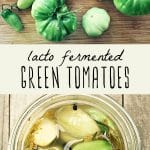
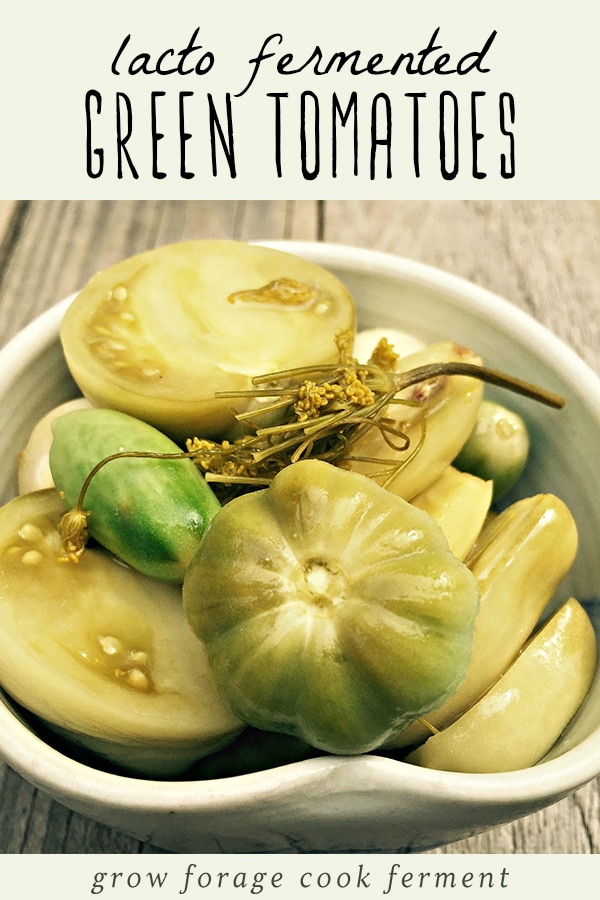
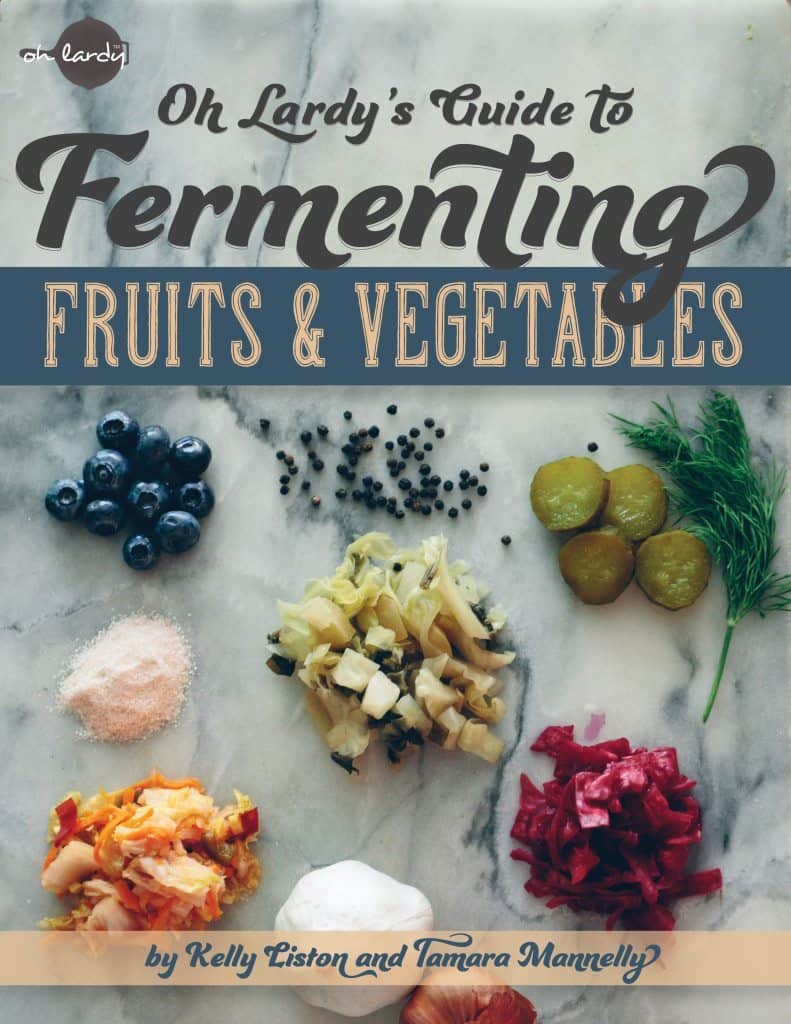
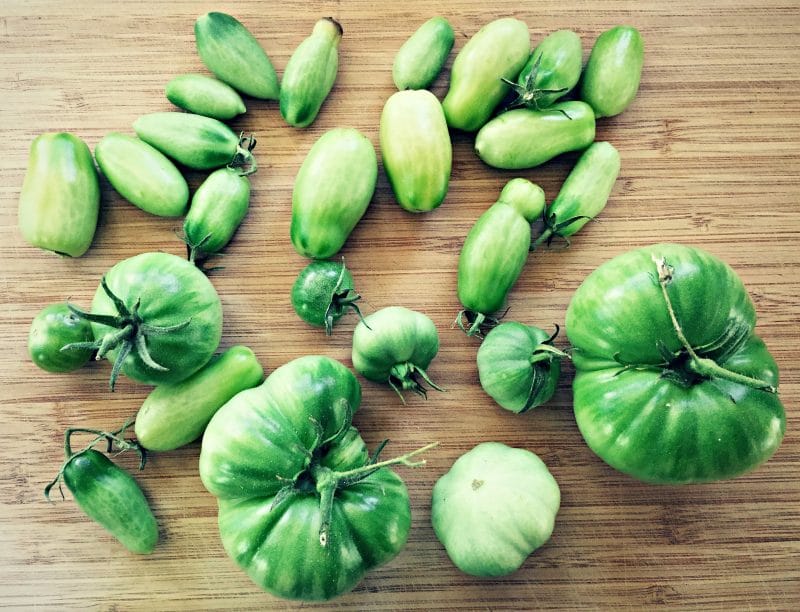
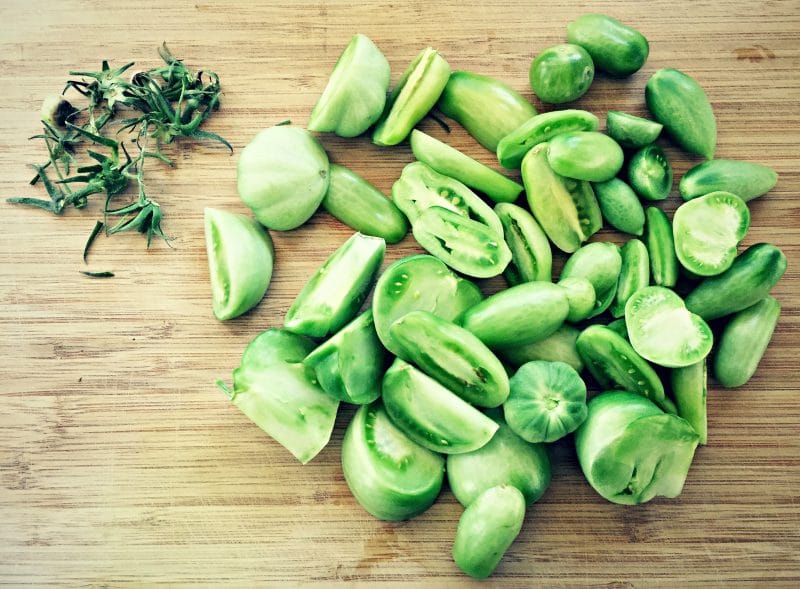
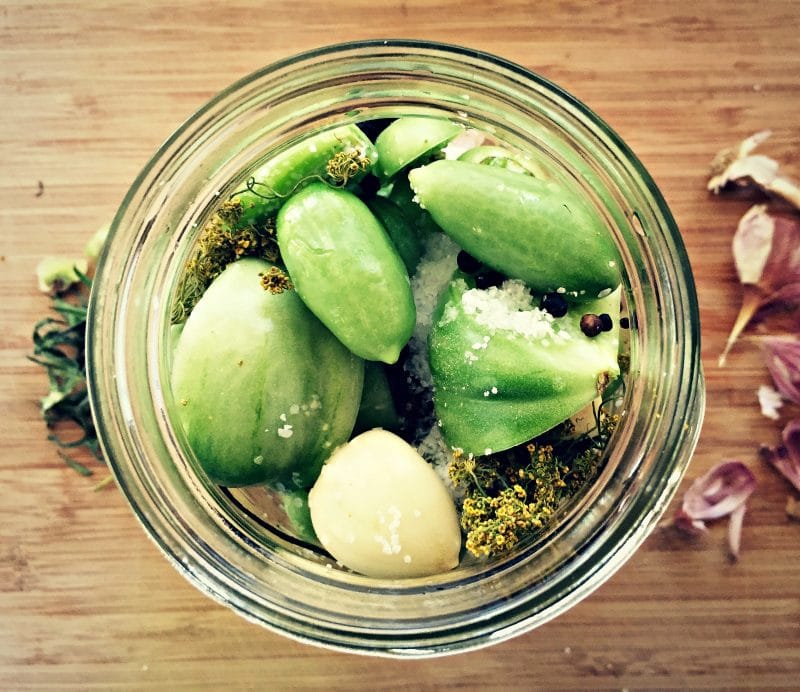
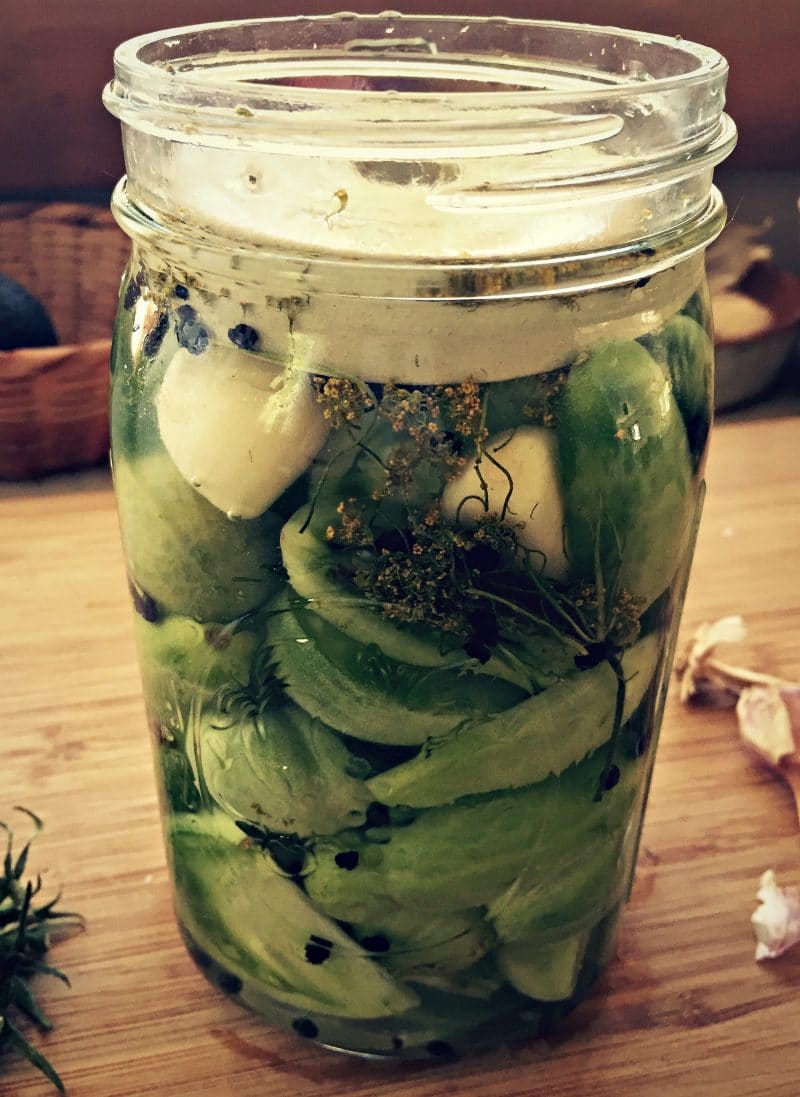
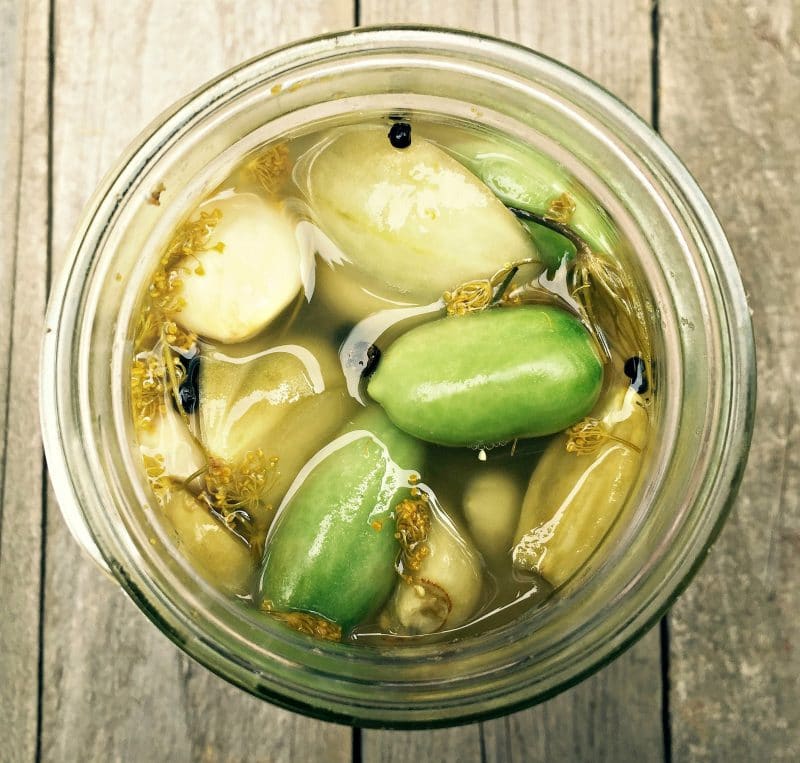
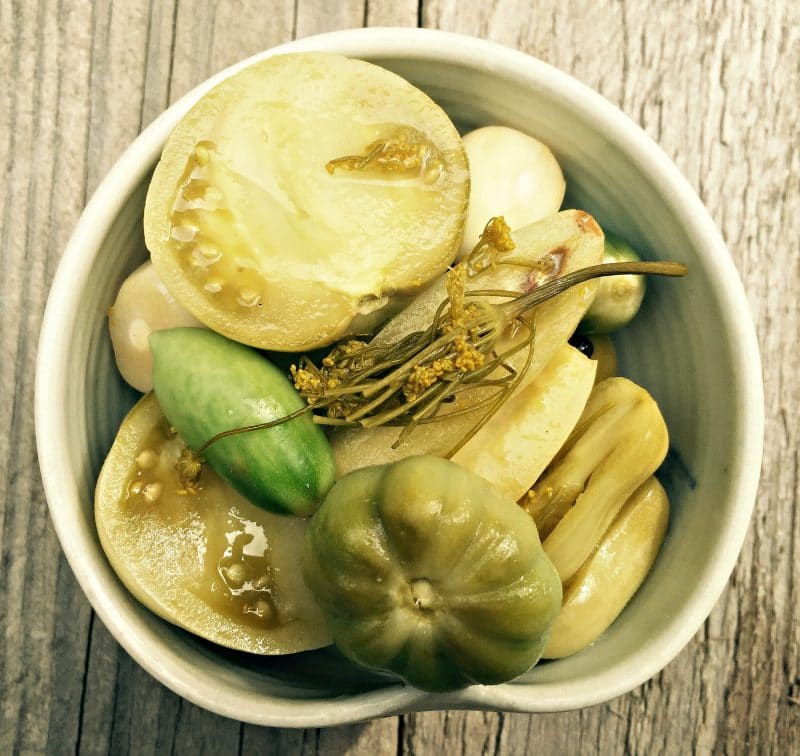
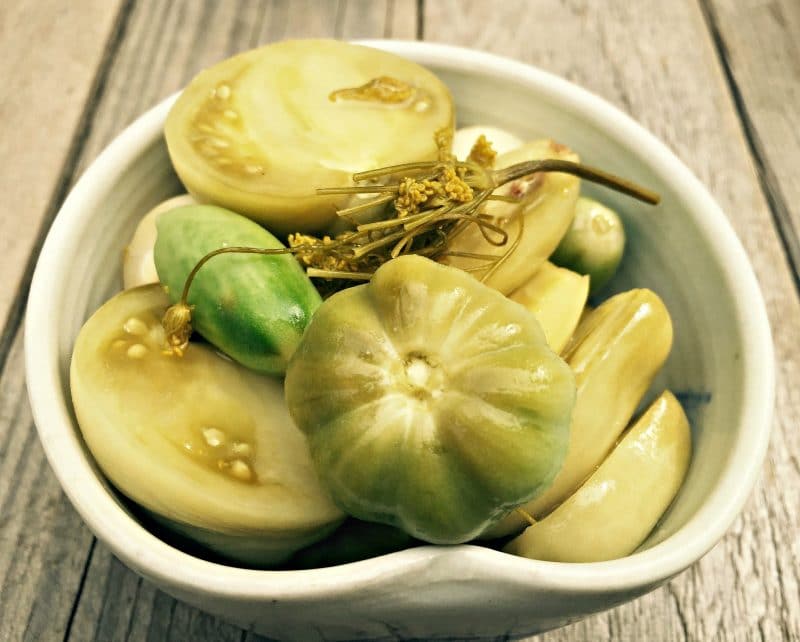


Hello, Thanks for your great recipes. I was wondering what i can use for culture starter. I have some juice left in my sauerkraut bottle. Could I use that. Thanks Linda
Hi Linda. Yes, you can use your sauerkraut juice as a starter culture.
I fermented my green tomatoes for about 5 weeks. Sorry, I see from the recipe that was too long. I’m more accustomed to fermenting saurkraut. Anyway, until a couple of days ago they looked great, but today the brine had turned cloudy and “threw a mother” (which is normal and necessary when you are making wine vinegar). Did I ruin them? Do I need to throw them away? Or is it ok that fermenting tomatoes throw a mother? — It’s in the fluid above the weight not actually on the tomatoes.
I’m sure you’ve decided what to do with your tomatoes by now, but I’ve had perfectly good lactose-fermented items that are ten years old! The cloudiness of the brine and the production of the ‘mother’ are all just stages of a successful facto-fermentation. The real trick is whether you like the flavor. Lacto-fermentation is perhaps the safest of all food preservation methods, so feel free to explore and enjoy.
Just a little confused. Do you have to use the whey or culture starter? Or do you not need to use anything like that. Thanks. I love fermented green tomatoes but have never attempted to make them. Also could you do a bunch at a time in a ceramic crock and then transfer to bottles?
Hi Nancy, no it is just an optional ingredient to get the ferment going faster. They will still ferment just fine without it though!
How do you store these after the 7 days? And how long do they last? Can I seal the jars?
They need to be stored in the refrigerator as with most fermented veggies. You wouldn’t want to seal them with a traditional canning process (boiling water) as that would kill all of the beneficial bacteria.
This recipe sounds fabulous and I will be using it in the future. Not this year, though, as the tomato horn worm got all my plants before they could produce. One criticism. Your post does not have a share option. Could you please change this for the future? I have set up my own group in which to save recipes I like and will be required to type your recipe into it, but will miss your beautiful pictures. Thank you.
Hi there, I do actually have share buttons at the top and bottom of every post :)
How long can you safely store them? Also, should they be refrigerated?
This is such a great recipe and I really look forward to rounding up enough green tomatoes to make several jars. I do not have to worry about not liking them, I know they will be fabulous if they are even more tart than dill pickles 😄
Your recipes never fail to impress! I love the pictures you include in your articles so that anyone who is a visual learner can see exactly how they should look at every step in the process. Super excited to try making these at home. I’ve been waiting to dip my toes in the water with this for so long!
Very timely article. I was hoping I would get some red tomatoes here in Colorado but the weather has turned cold and I don’t think that is going to happen. Hubby & I were just discussing what to do with all the green tomatoes and you just gave us an option. Thanks!
I really want to learn to do this. Glad I found this site.
The river rock idea is pure genius. BRB while I go find a couple the right size.
I always have an abundance of green tomatoes this time of year so this guide is super helpful! I definitely can’t wait to give this a try. Thank you for sharing and have a wonderful week :)
I made these today! Wish I found this recipe a few hours ago!
Mainly pickles this summer and some small batches of kraut and hot peppers (for hot sauce), green tomatoes are on my list as it gets close to the first frost.
I was fermenting chicken grain to make it more nutritious for my chickens, but found once the weather warmed up that it started to get a funny aroma. I didn’t want to poison them, so stopped and haven’t returned to the practice. I spout their grains now to get that extra nutrition and better body absorption and supplement their water with apple cider vinegar to get the extra nutrition and body benefits.
I’ve never even heard of fermenting green tomatoes! I don’t have any because my garden was non-existent this year, but I will try this for sure next fall.
Just finishing up a batch of fermented brussel sprout kimchi, next up fermented tomatillos. Never thought about green tomatoes, thanks for the idea!
I know it has been forever since you posted, but have you tried ground cherries? Kind of Luke mini tomatillas. I would adore trying them fermented!
I did not know that you could ferment all these fruits and vegetables – thanks for teaching us!
Love my sauerkraut! But I need to keep trying lots of new recipes for all the other vegetables to try and get my husband to eat them, too!
I just started with some fermenting and find I love it for my digestion issues.I am anxious to try the green tomatoes
It is getting cooler out so they won’t last long so fermenting sounds like a winner.
Yum! Looks great, I’ll have to give this a try. And in response to the giveaway- I haven’t fermented anything yet this season, but over the summer I did some radishes. In fact, My Favorite veggie to ferment is radishes!
This looks great. Gotta try it!
ive never had anything like this before…interesting.
I grew up learning to use green tomatoes in various dishes and a delicious relish-style preserve, and now I am inspired to try fermenting them as well. Thanks!
I’m currently making apple vinegar from cores and have some cilantro curtido started. Just love fermenting and creating little creatures that make good things to eat!
where do you get non chlorinated water? The whey can be left out?
Great questions! Usually regular city water is chlorinated, so you’d either need to filter it or buy filtered or bottled water. Well water is usually just fine, though. Yes, the whey just helps to get things going, but it’s not necessary. I’ve fermented many vegetables just fine without it!
If you leave chlorinated water out in the open for 24 hours the chlorine will evaporate.
I have pickled several batches of watermelon rinds but haven’t tried fermenting yet. Your blog is so inspiring I would love to try it soon!
I fermented jalapenos for my first experience fermenting. They are wonderful!!
Love this! Thanks for the visual guide!
I have only tried fermenting once and it was a chili sauce, turned out quite nice but I’m not sure how correct my process was.